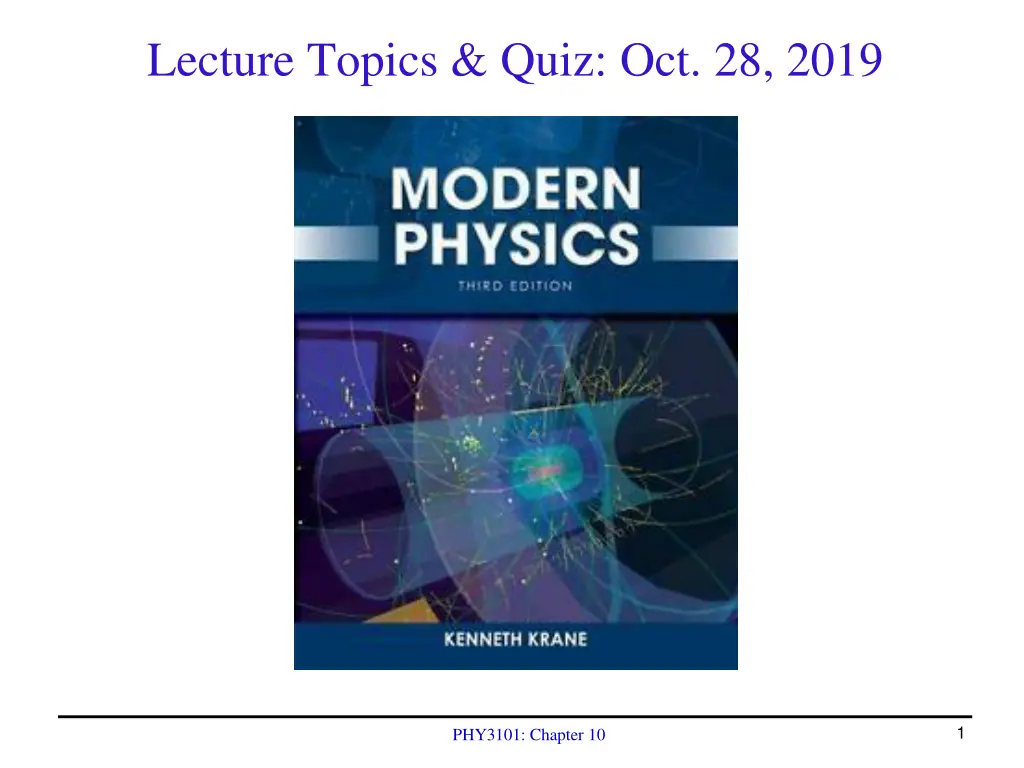
Identical Particle Wavefunctions and Microstate Macrostate Analysis
Explore topics covered in PHY3101 Chapter 10 lecture on identical particle wavefunctions, microstates, and macrostates. Understand the differences between classical particles, bosons, and fermions, along with statistical physics concepts like probabilities and density of states. Dive into the Maxwell-Boltzmann distribution and applications in the next session.
Uploaded on | 1 Views
Download Presentation

Please find below an Image/Link to download the presentation.
The content on the website is provided AS IS for your information and personal use only. It may not be sold, licensed, or shared on other websites without obtaining consent from the author. If you encounter any issues during the download, it is possible that the publisher has removed the file from their server.
You are allowed to download the files provided on this website for personal or commercial use, subject to the condition that they are used lawfully. All files are the property of their respective owners.
The content on the website is provided AS IS for your information and personal use only. It may not be sold, licensed, or shared on other websites without obtaining consent from the author.
E N D
Presentation Transcript
Lecture Topics & Quiz: Oct. 28, 2019 1 PHY3101: Chapter 10
Lecture Topics Oct. 28 What we just finished Wavefunctions of multiple particle system, identical particles, Differences between classical particles, bosons, fermions 2 identical particles in a box for classical, bosons, fermions Document 10A_identical_particles Today: Statistical Physics (Chap. 10) Microstates & macrostates & probabilities Probabilities for classical, fermion, boson Density of states Document 10B_statphys Next lecture (Chap. 10) Maxwell-Boltzmann distribution (energy, velocity). Applications Document 10C_MB_statistics 2 PHY3101: Chapter 10
HITT Points If you have 0 HITT points it most likely means that you didn t register your remote. Period 2 1 remote: 841646 2 remote: 846729 3 remote: 835761 4 remote: 836227 5 remote: 852175 Period 4 1 remote: 836858 2 remote: 842549 3 remote: 680941 3 PHY3101: Chapter 10
Class Survey Summary document here We will post on course website 4 PHY3101: Chapter 10
Fermions and Bosons Graviton: spin 2 5 PHY3101: Chapter 10
Two Particles in a 1-D Box Assume two non-interacting particles in a 1-D box (same mass) Wavefunction is described by two integers, one per particle E11= 2E0 Ground state (1,1) has Distinguishable non-interacting particles 6 PHY3101: Chapter 10
Identical Particle Wavefunctions ( )ybx2 ( )ybx2 ( ( ) ) ( )+ybx1 ( )-ybx1 ( )yax2 ( )yax2 ( ) ( ) yS ab= C yax1 yAab= C yax1 a b Swap particles: yS ba= +yS ab yAba= -yAab Bosons (spin 0, 1, 2, ) Fermions (spin 1/2, 3/2, Required by spin-statistics theorem! en.wikipedia.org/wiki/Spin-statistics_theorem 7 PHY3101: Chapter 10
2 Particles in Potential Box: Dramatic Difference! ( ) S P x1- x2 (n1,n2) = (1,2) A D 8 PHY3101: Chapter 10
Microstates and Macrostates Microstate example: gas system described per molecule 6N microstates (3 position, 3 velocity) Macrostate example: gas system described by overall properties Gas total energy, pressure, temperature, entropy 9 PHY3101: Chapter 10
Example: 2 Coins 10 PHY3101: Chapter 10
Example: 10 Coins 11 macrostates 1024 microstates (5H,5T) 252 microstates 210=1024 total states 11 PHY3101: Chapter 10
Consider Energy Levels (Distinguishable Particles) Q = 6 units of energy shared among N = 5 particles What is the distribution of individual energies for the 5 particles? 10 macrostates: A J W =(N +Q-1)! Q!(N -1)!=10! 6!4!= 210 microstates Next slide 12 PHY3101: Chapter 10
Energy Distribution (Counting from Diagram) 210 microstates E = 0: 420 = 4 E = 1: 280 = 4 5 E = 2: 175 = 1 1 5 E = 3: 100 = E = 4: 50 = 1 E = 5: 20 = + 1 E = 6: 5 = 1 5 1050 total Statistical physics axiom: Each microstate is equally likely (Next slide) 5 particles = 1050 individual energies 5 + 3 20 + 3 20 + 2 1 20 + 2 30 + 1 30 + 2 60 + 3 60 + 3 10 + 2 10 + 1 20 + 1 20 + 2 30 30 + 20 + 1 60 + 3 10 + 2 30 + 1 60 + 2 10 + 1 20 20 + 1 30 20 13 PHY3101: Chapter 10
Particle Energies: Boltzmann Energy Distribution Approximately exponential Boltzmann energy distribution. But ~exactly exponential when N ~ 1023, E huge 14 PHY3101: Chapter 10
Indistinguishable Particle Energy Distributions Major differences in counting indistinguishable particle states: Each macrostate has 1 microstate (they are indistinguishable) Spin fermions can have only 2 particles / energy level, so states with >2 particles are not possible (3 of 10 states allowed) 15 PHY3101: Chapter 10
Energy Distribution for Bosons/Fermions Bosons Fermions Easy to calculate from figure assuming 1 microstate/macrostate 16 PHY3101: Chapter 10
Distribution Functions Summary Distribution function is probability of a single particle having energy E at a given temperature T fMBE ( )= e-E/kBT fBEE ( )= Disting. particles (Maxwell-Boltzmann) 1 )/kBT-1 1 )/kBT+1 Bosons (Bose-Einstein) ( eE-m fFDE ( )= Fermions (Fermi-Dirac) ( eE-m = chemical potential (somewhat T dependent) For photons, = 0. Basis of Planck radiation formula Next slide: Plots of distributions for a given T 17 PHY3101: Chapter 10
1 )/kBT+1 fFDE ( )= ( eE-m 1 )/kBT-1 fBEE ( )= ( eE-m fMBE ( )= e-E/kBT 18 PHY3101: Chapter 10
Density of States For a fixed set of N particles and total energy E, we determined the particle energy distribution (MB, BE, FD) But we still don t know how many energy states are between energy E and E + dE. We define the density of states g(E) g E ( )dE g(E)dE = number density of particles between E and E + dE We work this out now 19 PHY3101: Chapter 10
Density of States (2) We imagine a very large cube containing the physical system For particles to be contained in the box, the wavefunction defining the available states is nyp y L 8 L3sinnxpx sinnzpz y x,y,z ( )= sin nx,ny,nzintegers L L ( ) h2n2 8mL2 h2 2+ ny 2+ nz 2 E = 8mL2nx (These integers are enormous for macroscopic systems) 20 PHY3101: Chapter 10
Density of States (3) 2+ ny 2+ nz 2 n= Let s define a spherical region defined by nx Define g(n) dn = # states/volume g(n)dn =1 ) 1 ( 8 4pn2dn L3 2s+1 # states in dn shell V # spin states g(E)dE = g(n)dn Can now calculate g(E) But 21 PHY3101: Chapter 10
Density of States (4) ( )4pn2dn 8L3 2s+1 g(n)dn = # states/volume E =h2n2 8mL2 h2 dE dn= 4mL2n g n ( ) dE / dn g E ( )= g n ( )dn dE= = g(E) =4p(2s+1) 2m3/2 E1/2 h3 22 PHY3101: Chapter 10
Particle Number Density Total number density between E and E + dE N E ( )= g E ( )f E ( ) where f(E) = # particles/energy state We determined f(E) for 3 cases: distinguishable, bosons, fermions fMB, fBE, fFD n N = g E ( )f E ( )dE Total # density V Example: Energy expectation value Eg E ( )f E ( )dE g E ( )f E ( )dE Eg E ( )f E ( )dE n E = = Examples next time 23 PHY3101: Chapter 10
f(E) Electron g(E) Electron Product 24 PHY3101: Chapter 10

